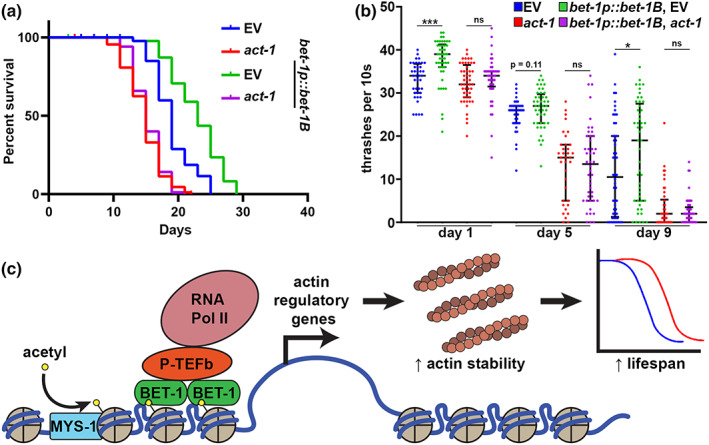FIGURE 6.

Bet‐1 overexpression promotes life span and healthspan through effects on actin. (a) Life spans of wild‐type, N2 (EV, blue) and bet‐1b overexpression (BET‐1p::bet‐1B, green) animals grown on EV or 10% act‐1 RNAi (N2, red; bet‐1B overexpression, purple) from hatch. N2, EV (blue) vs. bet‐1p::bet‐1B, EV (green) = p < 0.0001; N2 act‐1 RNAi (red) vs. bet‐1p::bet‐1B, act‐1 RNAi (purple) = not significant. See Tables S6 and S7 for life span complete statistics. (b) Thrashing assays were performed on N2 (EV, blue) and bet‐1B overexpression (bet‐1p::bet‐1B, green) animals grown on EV or 10% act‐1 RNAi (N2, red; bet‐1B overexpression, purple) from hatch. Animals were grown on FUDR to prevent progeny development and assayed on day 1, 5, and 9 of adulthood. Recordings were performed in M9 solution on a Leica M205FCA stereomicroscope with a Leica K5 camera and thrashing was scored manually over a 10 s recording. Data is representative of three independent trials. n = 36–54 worms per condition. ***p < 0.001; *p < 0.05; ns = p > 0.05 calculated using non‐parametric Mann–Whitney testing. Each dot represents a single animal and lines represent median and interquartile range. (c) Model for BET‐1 regulation of Actin. MYS‐1 acetylates histones (Ceol & Horvitz, 2004), allowing recruitment of BET‐1 to chromatin (Shibata et al., 2010). BET‐1 recruitment to chromatin allows for recruitment of transcription initiation factors like P‐TFEb, which allows recruitment of RNA pol II (Jang et al., 2005) to promote transcription of Actin regulatory genes, which promotes Actin function and life span.
